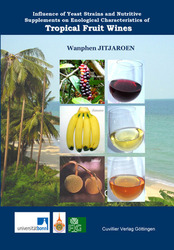| Fachbereiche | |
|---|---|
| Buchreihen (96) |
1377
|
| Nachhaltigkeit |
3
|
| Gesundheitswesen |
1
|
| Geisteswissenschaften |
2361
|
| Naturwissenschaften |
5403
|
| Mathematik | 229 |
| Informatik | 318 |
| Physik | 979 |
| Chemie | 1362 |
| Geowissenschaften | 131 |
| Humanmedizin | 243 |
| Zahn-, Mund- und Kieferheilkunde | 10 |
| Veterinärmedizin | 108 |
| Pharmazie | 147 |
| Biologie | 835 |
| Biochemie, Molekularbiologie, Gentechnologie | 121 |
| Biophysik | 25 |
| Ernährungs- und Haushaltswissenschaften | 45 |
| Land- und Agrarwissenschaften | 1004 |
| Forstwissenschaften | 201 |
| Gartenbauwissenschaft | 20 |
| Umweltforschung, Ökologie und Landespflege | 148 |
| Ingenieurwissenschaften |
1788
|
| Allgemein |
97
|
|
Leitlinien Unfallchirurgie
5. Auflage bestellen |
|
Erweiterte Suche
Influence of yeast strains and nutritive supplements on enological characteristics of tropical fruit wines
Wanphen Jitjaroen (Autor)Vorschau
Inhaltsverzeichnis, Datei (39 KB)
Leseprobe, Datei (83 KB)
The purpose of the study was to develop new processing techniques for tropical fruit wine production using banana, santol and ma-mao as model. Comprehensive information has been gathered on organic acids and soluble sugar concentrations of these juices. The optimal must preparation as well as the required yeast strains and nutritive supplements in fermenting wines were studied in detail. The musts were fermented at 25oC; addition of SO2 binding substances was limited to the minimum amount needed in order to provide adequate protection against oxidation and microbial contamination, and to comply with legal requirements. The enological parameters were investigated in terms of physicochemical, microbiological and sensory qualities. Banana puree for the base wine contained 32.5 g L-1 glucose and 31.4 g L-1 fructose. The main organic acids were 1.97 g L-1 malic acid and 1.42 g L-1 citric acid. The still present starch was degraded by Distizym BAT-special and Fructamyl FCT. Six incubation periods and enzyme combinations were studied. The highest amounts of glucose and fructose in the must were obtained by using 0.05% Distizym at 60oC for 5 h resulting in 95.4 g L-1 glucose and 81.7 g L-1 fructose. The musts were fermented with two yeast strains and six nutritive sources. Strain SIHA 3 produced vigorously with max. CO2 38 gL-1 d-1, and the fermentation period lasted 9 days. Perceptible dryness and target alcohol content, particularly supplemented with 1000 mg L-1 DAP, provided a low sulphur binding capacities of 26.1 mg L-1. The prominent aroma components formed were acetic acid ethylester, acetic acid 2 and 3-methylbutylester, 2 and 3-methyl-1-butanol and phenethyl alcohol. Santol juice based wine was a yellow-orange liquid containing 18.2 g L-1 glucose and 22.3 g L-1 fructose. The main organic acids were citric acid with 2.8 g L-1 and succinic acid with 0.4 g L-1. The remaining starch was degraded by Distizym BAT-special and Fructamyl FCT. Three incubation periods and enzyme combinations were studied. The highest amounts of glucose of 24.0 g L-1 and fructose of 27.9 g L-1 were obtained by using 0.05% Distizym at 60oC for 24 h. The must was fermented by two yeast strains with four nutritive sources. The yeast strains produced more than 40 g CO2 L-1 d-1, and the fermentation lasted 21 days. Yeast strain SIHA 3 with 1000 mg L-1 DAP and 0.6 mg L-1 thiamine showed a lesser sulphur binding capacity of 22.6 mg L-1. Addition of 0.05% pectinase enzyme significantly reduced the wine’s optical absorption value of 0.02 units resulting in a clear fruit wine. Most aroma components were formed after fermentation, and terpene compounds had slightly higher peak area ratios than wine without enzyme treatment. Ma-mao juice was a dark-red juice containing 28.53 g L-1 glucose and 26.96 g L-1 fructose. The main organic acids were 12.68-14.64 g L-1 citric acid and 3.18-3.50 g L-1 tartaric acid. The must was fermented by six nutrients with and without thiamine in combination. The fermentation ended slightly sluggish at the attenuation stage. The combination of 1000 mg L-1 DAP and 0.6 mg L-1 thiamine produced max. CO2 21.6 g L-1 d-1. Increasing nutrient addition as well as combining with thiamine reduced significantly pyruvate and α-ketoglutarate but still were perceived as sulphurous. Increasing amounts of four varying nutrient additions were further investigated. The 0.6 mg L-1 thiamine combination with 1000 or 2000 mg L-1 DAP produced CO2 25-30 g L-1 d-1, a higher intensity of red wine colour (1.30-1.40A) less pyruvate, acetaldehyde and α-ketoglutarate. Most prominent aroma compounds were higher alcohols followed by high esters and terpene compounds.
| ISBN-13 (Printausgabe) | 3867272344 |
| ISBN-13 (Printausgabe) | 9783867272346 |
| ISBN-13 (E-Book) | 9783736922341 |
| Buchendformat | A5 |
| Sprache | Englisch |
| Seitenanzahl | 98 |
| Umschlagkaschierung | glänzend |
| Auflage | 1 |
| Band | 0 |
| Erscheinungsort | Göttingen |
| Promotionsort | Bonn |
| Erscheinungsdatum | 16.05.2007 |
| Allgemeine Einordnung | Dissertation |
| Fachbereiche |
Chemie
Ernährungs- und Haushaltswissenschaften Land- und Agrarwissenschaften |








